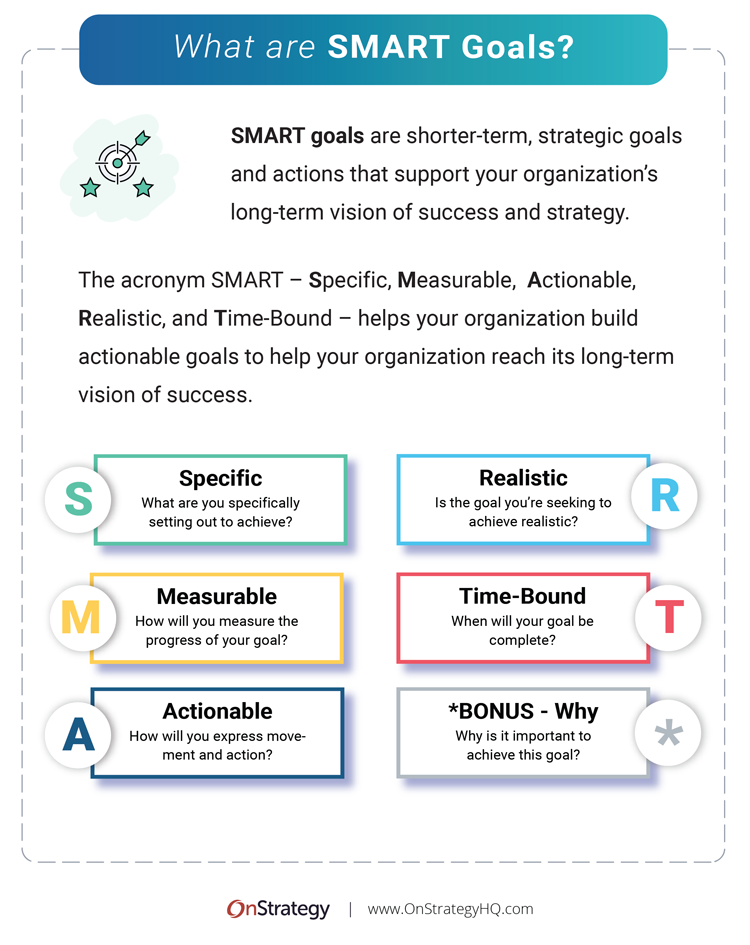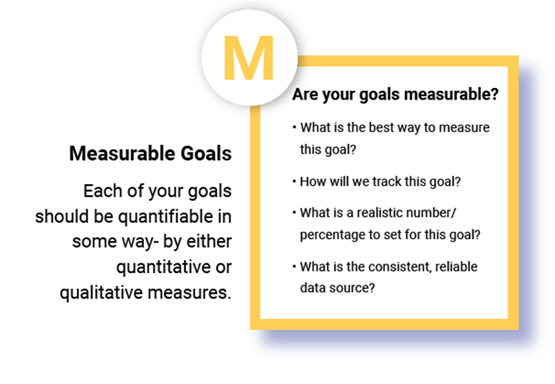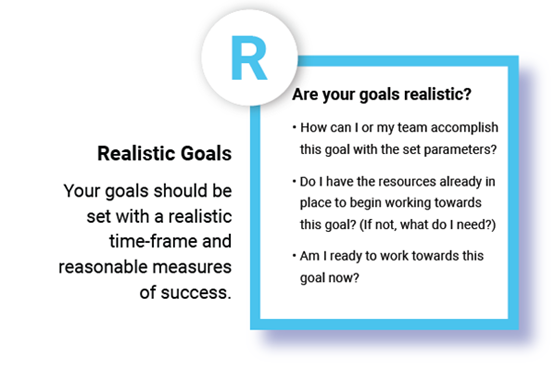SMART Goals Introduction:
SMART goals are short-term, strategic actions that support your organization’s long-term vision of success and strategy. The acronym SMART – Specific, Measurable, Attainable, Responsible, and Time-Bound – helps your organization build actionable goals to help it reach its long-term destination.
Setting goals for your organization and what you want your company’s future state to look like is essential to the strategy puzzle. While there are many principles and schools of thought on what you should aim for when creating your goals, we like to keep our goals SMART. We don’t just mean smart as in witty – but SMART goals stretch your organization to realize more of its full potential.
Pro Tip:
In Strategic Planning, SMART goals aren’t just an acronym or adjective, they’re a guiding principle. Creating great goals is where your plan meets the road and making them SMART creates action.

The SMART goal acronym explained:
SMART is a framework for goals and actions to make every goal detailed and specific so you can clearly understand what you’re setting out to achieve, how it’s measured, who is responsible, and when it’s due. SMART stands for:
- Specific – What are you specifically trying to achieve?
- Measurable – How will you measure success?
- Actionable – Does this goal inspire and communicate action?
- Realistic – Who is accountable for achieving this goal?
- Time-Bound – When is this goal due to be completed?
Check out this video from Erica Olsen where she outlines what SMART goals are and how to write SMART goals that support your organization’s long-term objectives:
Where do SMART goals fit into your strategic plan?
As you think about where SMART goals fit into your strategic plan, these rules specifically apply to your organizational annual goals [or objectives]. And as you cascade down through your plan, the SMART goal rules still apply.
Quarterly goals or actions still need to adhere to SMART goal rules – meaning they still need to be specific, measurable, actionable, realistic, and time-bound. These actions just happen to be quarterly in nature.
Pro Tip:
Are you using an OKR framework? Well, SMART still applies! Objectives and Key Results need to possess the same attributes of SMART goals.
Do you really need SMART goals?
YES.
Goals capture your aspirations and build out what it’s going to take to reach your vision of success. They create focus in daily work and require your team to center their focus on what matters most to your organization. They need to be embedded into your team’s every day.
As a bonus, when your SMART goals are short-term, you can go back and reassess regularly and either add new goals or adjust pre-existing ones. So, what makes up a SMART goal, and how should you approach each phase? Make sure to check out the SMART Goals Examples post for inspiration
Deep-dive into the SMART goal acronym
The SMART goal acronym is a helpful tool to create memorable and actionable goals.
Each letter of the acronym holds equal importance as the next, and helps you create well-rounded goals that express what you’re seeking to achieve, why you need to achieve it, and when it will be achieved by.
Pro Tip:
Each phase of the SMART goal designates a word that is just as important as the others in the acronym. You can’t spell ‘smart’ without an ‘S’ or an ‘A’, just like your goals can’t be SMART without being specific or attainable.

S – Specific
Every one of your goals needs to clearly express what you’re trying to achieve. The clearer your goals are and the whys are for each one, the easier it is to keep track of them. Specificity allows you to revisit your goals and pick up right where you left off. Additionally, it allows you to explain and justify the why of each goal to your stakeholders.
Pro Tip:
You’ve met the criteria for specific when you can revisit a goal after a week [or month] and still clearly understand what you’re setting out to achieve.
When setting specific goals, be sure to ask these questions:
- What do I want to accomplish with this goal?
- Why is this goal important to our overall objectives?
- What resources do we have already/need to be successful?
- How will we accomplish this?

M – Measurable
The next piece of the SMART goal puzzle is determining how you’ll measure your goal. To accurately assess if your goal is being met, it needs to be quantifiable in some way.
Quantitative measures are objective measures that can be counted, measured, or expressed using numbers or statistics. Examples of quantitative measures include sales figures, revenue, profit margins, and the number of customers served.
Qualitative measures, on the other hand, are subjective and descriptive measures that cannot be easily expressed using numbers or statistics. Examples of qualitative measures include customer satisfaction, brand reputation, or to measure project completion. Qualitative measures are typically used to assess the more abstract or intangibles of performance and are obtained through surveys, interviews, or other forms of subjective feedback.
When setting measurable goals, ask these questions:
- What is the best way to measure this goal?
- How will we track this goal?
- What is a realistic number/ percentage to set for this goal?
- What is the consistent, reliable data source?

A – Actionable
The standard acronym for SMART goals says that the goal should be attainable. And that’s true, but we like to instead use actionable.
Actionable goals ALWAYS start with a verb to inspire motion forward. There’s nothing worse than setting up a bunch of goals that don’t inspire any action. That’s why we always encourage teams to create goals with verbs.
When setting attainable goals, ask these questions:
- Does this communicate movement forward?
- Does the goal start with a verb?
- Will this goal help my team put our plan into meaningful action?

R – Realistic
Ensuring that your goals are attainable probably feels like a no-brainer. There’s no point in setting a goal if it’s not a goal you can achieve or reach.
Attainable goals can be determined in several ways. Make sure your goals are set in a realistic time frame with reasonable measures of success. Also, consider your access to resources and make sure you have the right tools in place to set your goals up for success.
When setting attainable goals, ask these questions:
- How can I or my team accomplish this goal with the set parameters?
- Do I have the resources (time, manpower, finances) already in place to begin working towards this goal? If not, what do we need?
- Am I ready to begin working towards this goal now?

T – Time Bound
The final phase of setting your SMART goals is ensuring that they are time-bound or time specific. Consider how long it will take to reach each goal and set markers and midway points. To ensure that you are achieving these goals within the timeline you’ve set, consider setting midway checkpoints as well.
When setting attainable goals, ask these questions:
- What do we want to accomplish in 3 months? 6 months? In 1 year?
- How do we know that this timeline is realistic?
- What are our midway benchmarks for these goals?

Bonus: Add a Why to ensure your goals are purposeful.
To make your goals feel more inspiring, we always recommend adding a short “why” statement to each goal. Don’t go overboard but add a short statement about the goal’s impact. It helps motivate your team.
When adding a “why” statement, consider these questions:
- Why does achieving this goal matter?
- What impact will it have?
- How does it create our future?
Final Thoughts:
Now that you’ve read this basic overview on what SMART goals are and how to apply these principles to your own goals, read our other articles on setting SMART goals and more!
What are SMART goals?
The SMART goal framework consists of a set of criteria that ensures that your goals are strategic and effective: every goal is Specific, Measurable, Actionable, Realistic, and Time-bound. Make sure your SMART goals are also assigned to a specific person!
Why do SMART goals need to be purposeful?
SMART goals are more inspiring so motivate your team to know why the goal is important and what the purpose for achieving it is. Without the ‘why’ there’s nothing to bring your team on board to your vision and long-term objectives.
Can OKRs also follow the SMART goal framework?
YES! SMART goals are not just an acronym or adjective, they are a guiding principle. And OKR objectives can and should be developed with the SMART goal criteria in mind.












